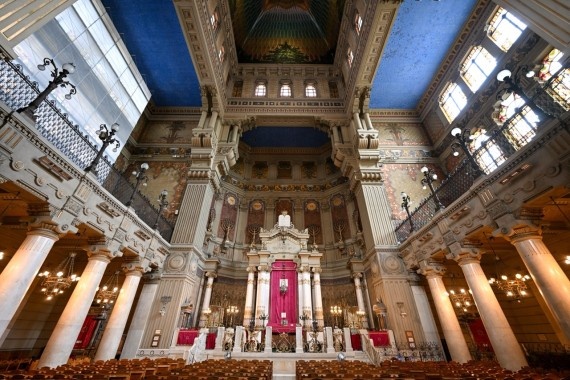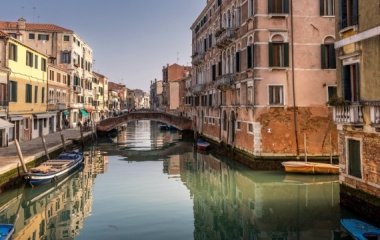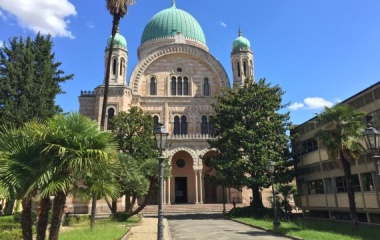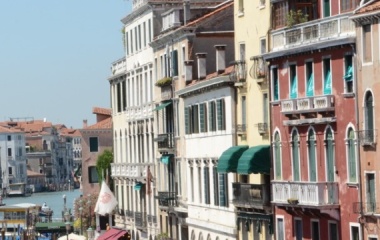
Italian Jewry is unique in many ways. Predating Ashkenazim and Sephardim, to this day they maintain their own nusach, prayer rite and customs[1]. Unaffected by the battles over religious reforms of 19th century Central and Western Europe changes happened organically. There was little need or desire for the Haskalah for the simple reason that Italian Jewry was always “enlightened” and its rabbis open to the best that foreign culture had to offer. There is much those who embrace a “modern orthodoxy” (and even those who don’t) can learn from a study of Italian Jewish history.
Living in the shadow of the Catholic Church the Jewish people, in keeping with official Church policy, suffered discrimination but never expulsions. There were times of relaxed restrictions and often very warm relations between Jews and Catholics. Jews were often well integrated in Italian society much more so than in other places. Many Jews – including many of the leading rabbis – attended the medical school in Padua, for many years the only medical school in Europe that accepted Jews.
It behooves us to briefly discuss some of the great rabbis who lived in Italy, whom we have yet to mention in our previous posts.
One of the most colourful rabbinic personalities to live in Venice was Yehuda Aryeh Modena (1571-1648) better known as Leon of Modena (it was commonplace for Italian rabbis from the Renaissance period onwards to have “secular” names). He served as a dayan, rabbinic judge, and official preacher of Venice and was the chazzan there for 40 years. He was sharply critical of Kabbalah and one of the first to claim the Zohar was a “modern” (medieval) work. He wrote a defence of Judaism for a non-Jewish audience, Historia de' Riti Hebraici and wrote a polemic against Christian dogma Magen VaHerev. Most unusually he wrote a deeply human autobiography, Chayei Yehuda, describing his personal and spiritual struggles, family tragedies along with his achievements. He does not shy away from discussing his struggles with his gambling addiction, an important message for all.
Rav Yitzchak Lampronti (1679-1756) introduced a new genre to the rabbinic corpus. His Pachad Yitzchak was the first alphabetic encyclopedia of halacha – something that is now quite common. He was the first to raise the issue of whether the killing of lice could still be permitted on Shabbat. The Talmud, (Shabbat 107b) under the impression that lice are spontaneously generated, ruled that one may kill lice on Shabbat as such is not to be considered taking away life. Trained in the sciences - he was a graduate of the medical school in Padua - he understood that the ancient assumption that there are species that spontaneously generate is incorrect and the killing of lice is taking away actual life. Thus began the question – still debated today – of how scientific discoveries should impact on halacha, Jewish law. Must halacha reflect scientific reality or is halachaguided by its own internal rules that work in conjunction with, but independent of, other disciplines? This question is not unique to halacha as all legal systems system grapple with the tension between “legal truth” and actual truth.
Undoubtedly, the most famous 18th century Italian rabbinic figure is the Ramchal, Rav Moshe Chaim Luzzatto, (1707-1746) author of what became the core text of the Mussar movement and one of the most studied works of Jewish ethics, Mesilat Yehsarim, The Path of the Just. His wide acceptance today is at great variance with how he was viewed in his lifetime.
A staunch kabbalist, single and all of twenty years old, he claimed to have been visited by an angel who relayed – presumably divine – messages. Coming soon after the Shabtai Zvi debacle made this strange behaviour more concerning. He was forced to hand over his many writings, most of which were either buried or burned. Branded a heretic, he fled to Amsterdam known for its more liberal environment. There he pursued his kabbalistic studies, worked as a diamond cutter and wrote (the non-kabbalistic) Mesilat Yesharim. Fascinatingly, but perhaps most appropriately, for many years the only English translation of the Mesilat Yesharim was authored by Mordechai Kaplan, another influential rabbi who, for very different reasons, was also ex-communicated.
In 1743 the Ramchal departed for Israel and along with his family sadly died in a plague three years later at the age of 39. Despite his young age and many of his books being lost to the Jewish people, he left a corpus of over 30 books including secular writings and books of poetry.
Moving to the 19th century we meet Shadal, Shmuel David Luzzatto (1860-1865). Like pretty much all Italian rabbis, he was knowledgeable in a wide range of fields. He was one of the first to use scientific tools in the study of the Torah, laying the groundwork for modern Jewish biblical scholarship. Foreshadowing much of the study of Tanach in the Modern Orthodox world, he focused on pshat[2], and at times offered (like many before him) commentary in variance with the view of the Sages. He was the most prominent teacher at the Rabbinic School of Padua, where he taught from its founding in 1829 until his death in 1865. The rabbinic school combined traditional Torah learning with modern academic studies, including philosophy, Hebrew grammar, and history. It reflected the influence of the Italian Haskalah, while remaining committed to halacha.
Sitting in shul in Milan I opened up the siddur and read the preface from Rav Yisrael Meir Lau, who wrote as follows (my translation from the Hebrew) “…This edition, rooted in the mountain of holiness, is based on the great masters of Italy of the past, first and foremost Rabbi S. D. Luzzatto zt”l based on the prayer rite that appears in the “machzor” that he edited…”.
There were many other important rabbinic figures who lived in Italy including The Aruch, Rabbeinu Chananel, The Abarbanel, Rabbi Azariah de Rossi, but discussing them will have to wait for our next Journey Through Jewish History to Italy.
[1] On fast days the custom worldwide is to read “Vayechal” the aftermath of the sin of the golden calf. Yet instead of reading the entire section the custom is to skip from Shemot 32:14 to chapter 34. I was in Milan for the 17th of Tammuz, and on the 17th of Tammuz and only on the 17th of Tammuz this is not skipped. What a meaningful and logical custom as our tradition teaches that it was on the 17th of Tammuz that the golden calf was built.
[2] Defining pshat is no easy task and much ink has been spilled trying to do so. For our purposes we can define it as the plain meaning of the text; the contextual meaning or perhaps the meaning as understood by the Jewish people who first received the Torah.



